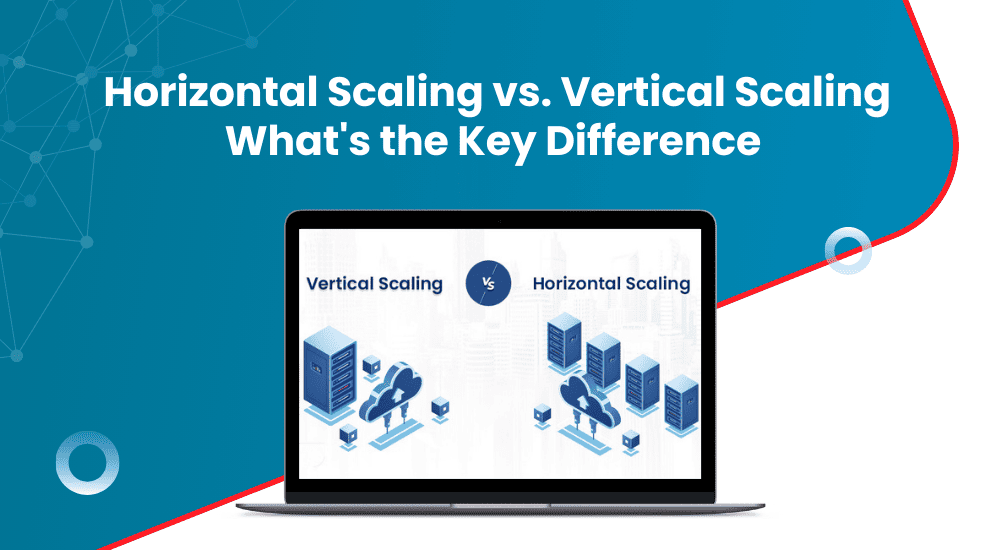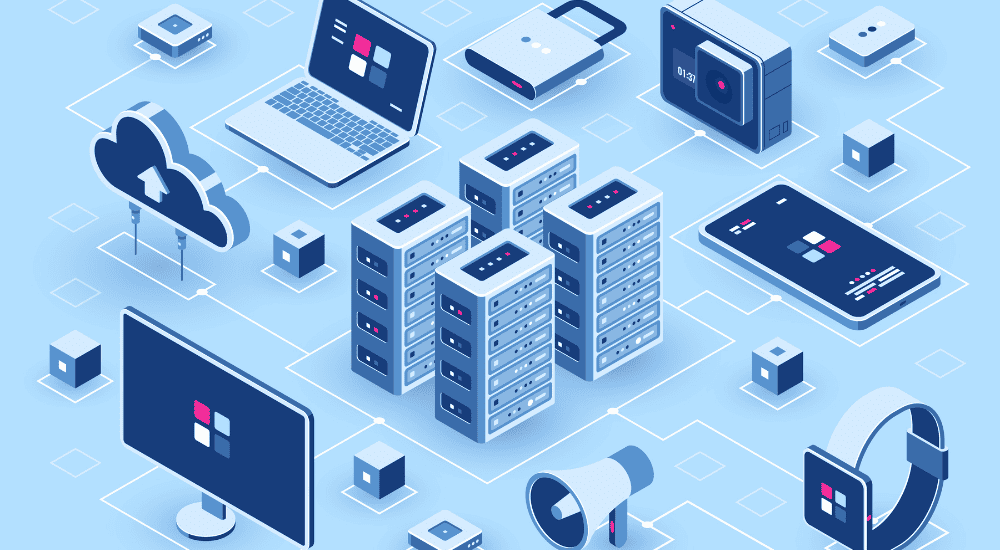
Horizontal Scaling vs. Vertical Scaling: What’s the Key Difference
In IT and cloud computing, you should be aware of the difference between horizontal and vertical scaling as a method of designing efficient and robust systems. Each approach has its advantages and disadvantages and may determine quite an influential factor on the performance and scalability of your applications.
In this blog post, we are going to discuss the concepts behind horizontal and vertical scaling, compare these two types of scaling, and describe their respective benefits and drawbacks.
Table of Contents
ToggleUnderstanding Scaling in IT: Horizontal vs. Vertical Scaling Explained
Let’s define what scaling is in IT talk before diving into the specifics of horizontal versus vertical scaling. Scaling refers to the capacity of a system to increase workload as more resources are added. As businesses grow and as their applications attract more users, the infrastructure needs to adapt to the growth so that performance and reliability are not compromised.
The two main ways this is accomplished are horizontal scaling and vertical scaling. Knowing the difference between the two types of scaling helps you decide what will work best for your infrastructure.
Horizontal Scaling Explained
Horizontal scaling, or “scalability,” is the addition of more machines or instances to a system. Instead of upgrading existing hardware, you add more servers or nodes to increase the number of available choices for handling the workload. This approach is quite common in distributed systems and cloud environments as well as in high-availability applications.
Key Features of Horizontal Scaling
- Distributed Load: Horizontal scaling also makes the load be spread across various servers reducing the opportunity of singular point failure. It allows an extra number of servers or nodes that distribute the workload so that bottlenecks are minimized thereby scaling out better than its counterpart.
- Cost-Effectiveness: Commodity hardware is used in the case of horizontal scaling, which is inexpensive in comparison to high-performance, very costly servers. Using commodity hardware is cheaper than investing in some expensive servers for vertical scaling.
- Flexibility: The dynamic nature of the model makes it easier to add or subtract more servers upon an increase in demand, thus having more flexibility with workload fluctuations than in dedicated models.
Horizontal Scaling Benefits
- Increased Reliability: Horizontal scaling gives less chance to be faced with a situation of downtime because of the distribution of workload across several servers. In case one fails, others could continue operating, keeping the system functioning.
- Elasticity: Horizontal scaling means that businesses can make as many adjustments as necessary on their resources with fluctuating demand. Adding or removing the servers can be done without complications, providing the means of scaling up or down according to needs.
- Performance: It is more helpful for applications because, with multiple server servicing requests, it helps applications respond to demands much quicker, especially during high-peak moments. It also is a distributed way of ensuring that performance is consistent.
When to Use Horizontal Scaling
Horizontal scaling is very helpful for such applications that have unpredictable workloads, for instance, web applications, microservices, or big databases. Such applications are well suited for cloud-native applications that require having a high availability level and can dynamically adjust according to changes in the user flow.

Vertical Scaling Explained
Vertical scaling, or “scaling up,” refers to the physical upgrade of existing machines for dealing with higher loads. This can include more CPUs added, more RAM, better storage capacity in a single server, and so on. Vertical scaling is generally seen in traditional environments where applications are hosted on dedicated servers.
Key Features of Vertical Scaling
- Simplicity: It becomes relatively easier to maintain systems in case you are working with one machine and not several servers, in which your system administration tasks will be less complicated.
- Reduced Complexity: You have fewer servers to contend with there also comes the lesser problems of data consistency that may arise. Problems of load balancing may come forth with network problems which may or may not occur in distributed environments.
- Immediate Performance Boost: With fewer servers to administer, there are fewer issues with consistency regarding data, plus fewer issues with load balancing and network-related issues within the distributed systems.
Advantages of Vertical Scaling:
- Lower Complexity: Fewer servers mean reduced complexity concerning configuration, maintenance, and potential problems relating to distributed systems, including synchronization of data.
- Better for Legacy Applications: Most older systems are engineered to be run on one server, so vertical scaling is the feasible way to enhance their performance without large changes being necessary.
- Resource Concentration: In other words, the vertical scale of all resources helps the concentration of resources to be distributed by one machine. It can be a very useful application for those who work with intense processing or special configurations in hardware.
When to Use Vertical Scaling
Vertical scaling is the most suitable for applications where, although requiring good performance from individual machines, cannot easily be distributed among several nodes. It is often used in database management systems or applications, mostly when latency requirements are very strictly posed.
Differences in Scaling Methods
Understanding these differences in scaling methods can help businesses choose the right approach for their needs. Here are some critical distinctions:
Resource Limitations
- Horizontal Scaling: Adding more servers or instances to distribute the load across several machines. Generally less costly since it leverages commodity hardware; hence, investment is very incremental. More complicated because of the need for load balancing, data replication, and maintaining distributed systems.
- Vertical Scaling: Focus on the upgrade of a single server-a possible upgrade of its hardware resources, like CPU, RAM, or storage. Usually more expensive due to the necessity of high-performance, specialized hardware.
Manages it in a simpler form since only one node exists, which means that any potential node administration complexity is reduced.
Downtime Considerations
- Horizontal Scaling: It improves performance by serving requests across several servers which can handle the most number of parallel connections, and it also promises to have virtually unlimited scalability since it allows users to increment as needed with no significant restrictions on adding multiple servers.
- Vertical Scaling: This provides immediate performance enhancements for resource-intensive applications on the same machine. However, this is constrained by the utmost capabilities of the hardware and will eventually top out potential growth.
Data Management
- Horizontal Scaling: Adds new servers relatively rapidly, and most of the time with no detected downtime at all. For web applications, microservices, and in situations where workloads are very much there is maximum flexibility.
Requires elaborate data management techniques, including replication and synchronization, to maintain consistency among the nodes. - Vertical Scaling: An upgrade could also necessarily mean more downtime since the system needs to be placed offline to allow for improvements in the hardware. Better suited for applications that require high performance from a single node, such as databases and legacy systems.
System Scaling Techniques
- Load Balancing: This approach would ensure that incoming network traffic is spread across several servers so that no server is burdened with loads. Load balancers spread out the performance and fault tolerance by routing traffic to servers that do not have faults.
- Clustering: Comprises clumping of more than one server together so that it behaves as a single system. Clustering has been shown to increase availability and fault tolerance, and such systems can function without the failure of one node.
- Vertical Scaling Strategies: Auto-scaling on cloud environments sets it in a way that the number of active servers increases and decreases according to the high demand placed at present. This technique allows systems to scale up during peak times and down during low usage, optimizing resource allocation.
- Containerization: Applications and their dependencies can be containerized for rapid and efficient deployment and scaling. Containers are very easily duplicated and, hence, deployment across the various environments is quite straightforward, thus making it possible to scale very fast due to demand.
Conclusion
In simple terms, it depends on the needs of your application and your business to horizontal vs. vertical scaling. Horizontal scaling provides flexibility and resilience in a dynamic environment and applications with varied workloads. In contrast, vertical scaling provides simplicity in addition to immediate delivery and performance boosts to applications that have precise resource demands.
It will help you design an architecture that is appropriate for your organization by letting you understand differences in scaling techniques, their advantages, and when you use one.
Be it scaling out or scaling up, having a clear strategy on system scaling techniques will ensure that your infrastructure can grow with the business. Of all the above, your organizations will have better decisions that optimize performance, minimize costs, and achieve optimal user experiences.